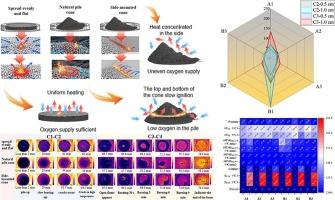填料结构对AlMg合金粉末热致自燃的影响
IF 4.6
2区 工程技术
Q2 ENGINEERING, CHEMICAL
引用次数: 0
摘要
镁合金粉末在3D打印和高能材料中的广泛应用,给能源开发和安全带来了重大的热自燃风险。为了系统地研究不同粉尘填料结构对热激发下AlMg合金粉末自燃特性的影响,设计了一套实验系统。通过温度演化、火焰传播行为和可视化热扩散路径的时空分析,我们揭示了填料结构在控制传热和着火风险方面的主导作用。结果表明,叠合AlMg合金粉末的最低自燃温度较低,仅在310 ~ 320℃左右。对于60 μm的粉末,在1298℃时,质量增加了187%。此外,细粉表现出多阶段放热行为,反映了更复杂的氧化途径。其中,60 μm均匀铺展结构的粉末由于其导热路径短,传热效率高,升温速率最高,内部温升可达134.4℃/min。该结构具有较高的(dT/ dT)max、最快的温升和最严重的着火危险,具有明显的同心火焰传播模式。相比之下,自然填料呈现出“从外到上、逐层燃烧”的行为,而侧堆叠结构则呈现出“单向横向火焰蔓延”。采用机器学习方法对关键热参数进行聚类,实现了着火风险分类和危险条件的预测评估。这项工作阐明了填料结构调节热点火行为的机制,并为高能粉末材料的安全设计和管理提供了数据驱动的见解。本文章由计算机程序翻译,如有差异,请以英文原文为准。

Influence of packing structure on the thermal-induced self-ignition of AlMg alloy powder
Al![]() Mg alloy powder's wide use in 3D printing and energetic materials poses major thermal self-ignition risks to energy development and safety. In this study, a custom-designed experimental system was developed to systematically investigate how various dust packing structures influence the self-ignition characteristics of Al
Mg alloy powder's wide use in 3D printing and energetic materials poses major thermal self-ignition risks to energy development and safety. In this study, a custom-designed experimental system was developed to systematically investigate how various dust packing structures influence the self-ignition characteristics of Al![]() Mg alloy powder under thermal stimulation. Through spatiotemporal analysis of temperature evolution, flame propagation behavior, and visualized thermal diffusion pathways, we reveal the dominant role of packing configurations in governing heat transfer and ignition risk. The results demonstrate that stacked Al
Mg alloy powder under thermal stimulation. Through spatiotemporal analysis of temperature evolution, flame propagation behavior, and visualized thermal diffusion pathways, we reveal the dominant role of packing configurations in governing heat transfer and ignition risk. The results demonstrate that stacked Al![]() Mg alloy powders exhibit a relatively low minimum self-ignition temperature, occurring at only about 310–320 °C. For 60 μm powders, the mass increase reached 187 % at 1298 °C. Moreover, finer powders exhibited multi-stage exothermic behaviors, reflecting more complex oxidation pathways. Among the tested configurations, the uniformly spread structure of 60 μm powders showed the highest heating rate, with an internal temperature rise up to 134.4 °C/min, owing to its short thermal conduction path and efficient heat transfer.This structure consistently exhibited higher (dT/dt)max, the fastest temperature rise, and the most severe ignition hazard, with a distinct concentric flame propagation pattern. In contrast, natural packing presents an “outside-to-top, layer-by-layer combustion” behavior, while side-stacked configurations display “unidirectional lateral flame spread.” A machine learning approach was employed for clustering of key thermal parameters, enabling classification of ignition risks and predictive assessment of hazardous conditions. This work elucidates the mechanisms by which packing structures modulate thermal ignition behavior and offers data-driven insights for the safe design and management of high-energy powder materials.
Mg alloy powders exhibit a relatively low minimum self-ignition temperature, occurring at only about 310–320 °C. For 60 μm powders, the mass increase reached 187 % at 1298 °C. Moreover, finer powders exhibited multi-stage exothermic behaviors, reflecting more complex oxidation pathways. Among the tested configurations, the uniformly spread structure of 60 μm powders showed the highest heating rate, with an internal temperature rise up to 134.4 °C/min, owing to its short thermal conduction path and efficient heat transfer.This structure consistently exhibited higher (dT/dt)max, the fastest temperature rise, and the most severe ignition hazard, with a distinct concentric flame propagation pattern. In contrast, natural packing presents an “outside-to-top, layer-by-layer combustion” behavior, while side-stacked configurations display “unidirectional lateral flame spread.” A machine learning approach was employed for clustering of key thermal parameters, enabling classification of ignition risks and predictive assessment of hazardous conditions. This work elucidates the mechanisms by which packing structures modulate thermal ignition behavior and offers data-driven insights for the safe design and management of high-energy powder materials.
求助全文
通过发布文献求助,成功后即可免费获取论文全文。
去求助
来源期刊

Powder Technology
工程技术-工程:化工
CiteScore
9.90
自引率
15.40%
发文量
1047
审稿时长
46 days
期刊介绍:
Powder Technology is an International Journal on the Science and Technology of Wet and Dry Particulate Systems. Powder Technology publishes papers on all aspects of the formation of particles and their characterisation and on the study of systems containing particulate solids. No limitation is imposed on the size of the particles, which may range from nanometre scale, as in pigments or aerosols, to that of mined or quarried materials. The following list of topics is not intended to be comprehensive, but rather to indicate typical subjects which fall within the scope of the journal's interests:
Formation and synthesis of particles by precipitation and other methods.
Modification of particles by agglomeration, coating, comminution and attrition.
Characterisation of the size, shape, surface area, pore structure and strength of particles and agglomerates (including the origins and effects of inter particle forces).
Packing, failure, flow and permeability of assemblies of particles.
Particle-particle interactions and suspension rheology.
Handling and processing operations such as slurry flow, fluidization, pneumatic conveying.
Interactions between particles and their environment, including delivery of particulate products to the body.
Applications of particle technology in production of pharmaceuticals, chemicals, foods, pigments, structural, and functional materials and in environmental and energy related matters.
For materials-oriented contributions we are looking for articles revealing the effect of particle/powder characteristics (size, morphology and composition, in that order) on material performance or functionality and, ideally, comparison to any industrial standard.
 求助内容:
求助内容: 应助结果提醒方式:
应助结果提醒方式:


